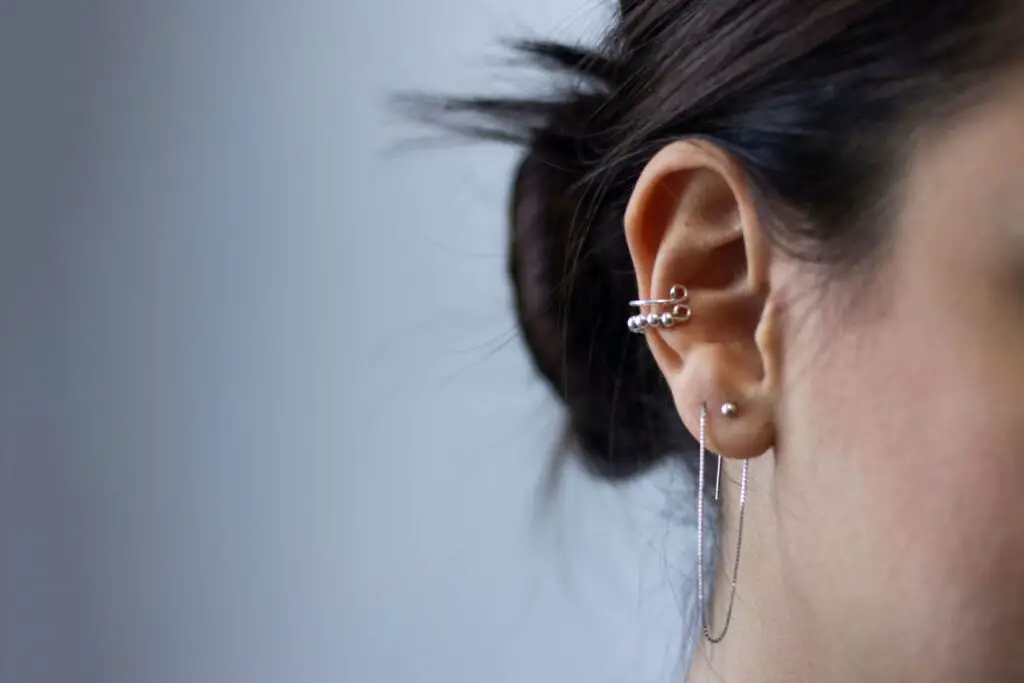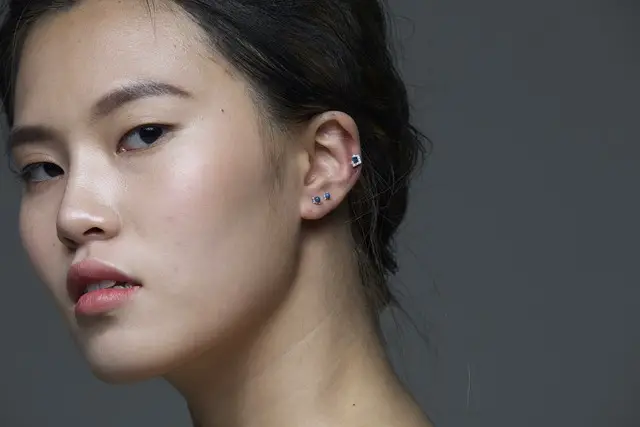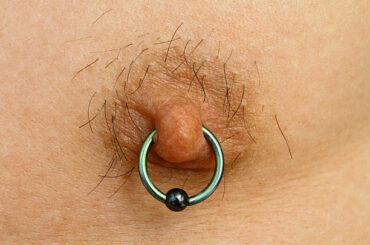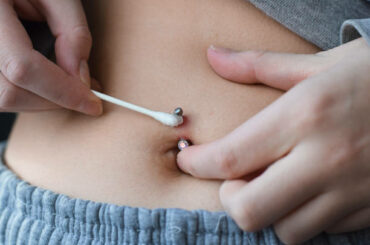Contents
Industrial Piercing Anatomy

Body modifications have long served as a canvas for personal expression, and one of the most captivating and distinctive forms of piercing is industrial piercing. If you’re intrigued by the idea of this unique adornment, you’re not alone. Industrial piercings have gained popularity for their unconventional and eye-catching appearance. In this article, we will delve into the fascinating world of industrial piercing anatomy, providing you with a comprehensive understanding of what it entails.
Defining Industrial Piercing:
An industrial piercing is not your typical earlobe piercing. It’s a bold and daring choice that involves a specific placement and jewelry design. In an industrial piercing, two piercings are connected by a single barbell, creating an avant-garde aesthetic that defies convention.
The Significance of Understanding the Anatomy:
To embark on the journey of an industrial piercing, it’s vital to grasp the intricacies of the ear’s anatomy. Each component of the ear plays a crucial role in the placement and healing of the piercings. Understanding this anatomy is not just a matter of curiosity; it’s the key to ensuring a successful and safe industrial piercing experience.
What This Article Will Cover:
This article will be your comprehensive guide to industrial piercing anatomy. We’ll start by dissecting the various elements of the ear involved in this unique modification, including the helix and antihelix. Then, we’ll explore the specific placement of the piercings and the types of industrial piercings you can opt for.
Next, we’ll discuss the role of jewelry in industrial piercings and how it connects the two piercings to create the signature look. You’ll gain insights into the sensations and healing process associated with industrial piercings and learn about potential complications to watch out for.
Furthermore, we’ll emphasize the importance of finding a professional piercer who understands the nuances of industrial piercing anatomy and how to ensure your safety during the procedure.
In conclusion, by the end of this article, you’ll have a comprehensive understanding of industrial piercing anatomy, making you well-equipped to make an informed decision if you’re considering this unique form of body modification. So, let’s journey into the fascinating world of industrial piercing anatomy together.
The Ear’s Anatomy
Before delving into the specifics of industrial piercing anatomy, let’s establish a foundational understanding of the basic structure of the human ear. In the context of industrial piercings, we’ll focus on the relevant components of the outer ear.
1. Cartilage and Its Importance:
Cartilage: The outer ear primarily consists of cartilage, a tough, flexible tissue that provides the ear’s shape and structure. This cartilage is essential to support the industrial piercing.
Firmness and Resilience: Cartilage is firmer than the soft tissue found in other parts of the body, making it suitable for piercings. Its resilience allows for the placement of jewelry.
2. The Helix:
Definition: The helix is the prominent, outer, curved rim of the ear. It is the most common location for the first piercing in an industrial piercing.
Helix Piercing: Industrial piercings often begin with a piercing through the helix. This location provides a stable base for the jewelry that connects the two piercings.
3. The Antihelix:
Definition: The antihelix is situated just inside the helix and forms a curved ridge in the middle ear. It’s located closer to the head than the helix.
Relevance to Industrial Piercing: The second piercing in an industrial piercing is typically placed through the antihelix. The alignment and placement of the antihelix piercing are critical to achieving the desired aesthetic and functionality of the industrial piercing.
4. Cartilage’s Role in Industrial Piercing:
Stability and Durability: Cartilage provides the stability and durability required for industrial piercings. It allows the jewelry to be securely anchored, creating the distinct appearance of two piercings connected by a single barbell.
Healing Process: The presence of cartilage affects the healing process. Cartilage piercings, including those in the helix and antihelix, often require more extended healing times compared to piercings through soft tissue.
Understanding the cartilaginous nature of the outer ear, along with the specific components involved, lays the foundation for comprehending the intricacies of industrial piercing anatomy. As we continue our exploration, we’ll delve deeper into the placement, jewelry, sensations, and healing process associated with this unique form of body modification.
Industrial Piercing Placement

The distinct and captivating look of an industrial piercing relies heavily on precise placement. It involves the strategic piercing of two locations on the ear, the helix and antihelix, and the connection of these two piercings by a single piece of jewelry. Let’s explore the intricacies of industrial piercing placement:
1. The Helix Piercing:
Location: The helix piercing, the starting point for an industrial piercing, is typically situated on the outer rim of the ear. This area provides a stable foundation for the jewelry.
Piercing Angle: The piercing needle enters the helix at a specific angle, often perpendicular to the skin. The angle is crucial to ensure the jewelry aligns correctly with the antihelix piercing.
2. The Antihelix Piercing:
Location: The second piercing in an industrial piercing is placed through the antihelix, which is the curved ridge inside the ear, closer to the head.
Alignment: The alignment of the antihelix piercing is essential. It should be positioned in a way that allows the jewelry to pass through both the helix and antihelix, creating a seamless connection.
3. Connection and Jewelry:
Single Barbell: The unique aspect of industrial piercing lies in the connection between the helix and the antihelix. A single straight or curved barbell is threaded through both piercings, securing them together.
Achieving the Desired Appearance: Achieving the desired appearance in an industrial piercing involves careful alignment of the jewelry. The jewelry should pass through both piercings in a way that creates a visually pleasing and symmetrical effect.
Angles and Precision: Piercers must exercise precision in determining the angles and distances between the two piercings. The success of the piercing’s overall aesthetic hinges on the accuracy of these measurements.
4. Alignment and Angles:
Parallel Placement: To achieve the iconic industrial look, the two piercings should be parallel to each other. This parallel alignment ensures that the jewelry flows seamlessly through both piercings.
Angles for Variations: Different variations of industrial piercings may involve slight variations in angles or placements. Some individuals prefer a more unique or customized appearance, and piercers can accommodate these preferences.
In summary, industrial piercing placement is a delicate art that requires precision and attention to detail. The helix and antihelix piercings must be strategically aligned to allow for the seamless passage of a single piece of jewelry. Achieving the desired appearance in an industrial piercing relies on the expertise of the piercer, who carefully considers angles, distances, and the unique anatomy of the ear to create a stunning and distinctive result.
Types of Industrial Piercings

Industrial piercings are not limited to a single style; instead, they offer a range of variations, each with its unique charm and aesthetic appeal. Let’s explore some of the different types of industrial piercings, including vertical industrials and forward helix-to-helix industrials, and understand how these variations affect both the piercing’s anatomy and style:
1. Vertical Industrials:
Description: Vertical industrials involve two piercings that run vertically along the ear’s cartilage. One piercing is located at the top of the helix, and the other is situated near the antihelix, running parallel but vertically.
Piercing Locations: The upper helix and lower antihelix are the key locations for vertical industrials. The vertical alignment creates a distinctive appearance, emphasizing the height of the ear.
Aesthetic Impact: Vertical industrials provide a striking, elongated look that draws attention to the height of the ear. This style allows for unique jewelry placement, often featuring long, decorative barbells that enhance the vertical orientation.
2. Forward Helix-to-Helix Industrials:
Description: Forward helix-to-helix industrials take a different approach by connecting two forward helix piercings located on the outer ear’s front side.
Piercing Locations: Two forward helix piercings are positioned close together on the ear’s front surface. The jewelry connects these two piercings by traversing through the helix’s thin cartilage.
Aesthetic Impact: This style creates a visually captivating and unconventional look. It emphasizes the front-facing part of the ear, enhancing its visibility. Jewelry choices, such as unique barbells or chains, can further accentuate the style.
3. Custom Variations:
Personalized Aesthetics: Beyond the standard vertical and forward helix-to-helix industrials, many individuals opt for custom variations. These may involve different placements, angles, or even combining multiple types of piercings to achieve a unique look.
Individual Style: Customized industrial piercings allow for a personalized expression of style and individuality. Whether you prefer a minimalist, edgy, or avant-garde appearance, custom variations offer endless possibilities.
Impact on Piercing’s Anatomy and Style:
Anatomy Adaptation: Different types of industrial piercings require specific placements and angles. Piercers must adapt their techniques to ensure the jewelry aligns correctly and comfortably.
Style Diversity: The choice of industrial piercing style significantly impacts the overall look. Vertical industrials elongate the ear, while forward helix-to-helix industrials emphasize the front-facing aspect. Custom variations offer unlimited options for personal style expression.
In summary, industrial piercings offer a diverse range of styles, including vertical industrials and forward helix-to-helix industrials, each with its unique anatomy and aesthetic impact. These variations allow individuals to choose a style that resonates with their personality, sense of style, and desired appearance, making industrial piercings a versatile and customizable form of body modification.
The Role of Jewelry
Jewelry plays a pivotal role in any piercing, but it takes on a particularly significant role in industrial piercings. The choice of jewelry not only influences the aesthetics but also affects the overall comfort and function of the piercing. Let’s delve into the significance of jewelry in industrial piercings, describe the common types used, typically barbells, and explore how jewelry connects the two piercings to shape the overall look:
1. Significance of Jewelry:
Aesthetic Enhancement: Industrial piercing jewelry is more than just an accessory; it’s an integral part of the piercing’s overall aesthetic. The right jewelry choice can enhance the striking appearance of the piercing.
Connection: Jewelry serves as the connector between the two piercings, creating the hallmark appearance of an industrial piercing. It’s the bridge that unites the helix and antihelix piercings, making them a cohesive unit.
Style Expression: The jewelry you select is a powerful means of self-expression. Whether you opt for a minimalist barbell or an ornate and decorative piece, your choice reflects your personal style and aesthetic preferences.
2. Common Jewelry Used: Barbells:
Straight Barbells: Straight barbells are the most common choice for industrial piercings. They consist of a straight rod with threaded ends that can be unscrewed to insert the jewelry.
Curved Barbells: Curved barbells are also used in some industrial piercings, especially for variations that require a curved trajectory. These barbells follow the natural contours of the ear’s anatomy.
Materials: Industrial piercing jewelry is typically made from materials like surgical steel, titanium, or biocompatible materials. These materials are chosen for their hypoallergenic properties and durability.
3. Connection and Aesthetic Influence:
Connecting the Two Piercings: The jewelry used in an industrial piercing connects the two piercings—the helix and the antihelix. It passes through both piercings, creating a visual bridge that unites them.
Influencing the Overall Look: The choice of jewelry can significantly influence the overall appearance of the industrial piercing. For example:
A simple and sleek straight barbell imparts a minimalist and contemporary look.
Decorative ends, featuring gemstones or unique designs, add an element of sophistication or individuality.
Ornate or custom-designed jewelry can turn an industrial piercing into a true work of art.
Customization: Many individuals opt for customized jewelry to make their industrial piercing truly unique. Custom jewelry allows for personalization and may include intricate designs or initials, showcasing the wearer’s personality and style.
In conclusion, jewelry is not merely an accessory in industrial piercings; it’s a critical component that defines the piercing’s character and style. Whether you choose a simple straight barbell or an elaborate custom piece, your jewelry selection will leave a lasting impression. It’s a testament to your individuality and a significant factor in the overall impact of your industrial piercing.

Pain, Sensation, and Healing
Undergoing an industrial piercing is an exciting and transformative experience, but it’s natural to have questions about the associated pain, sensations, and the healing process. In this section, we will address these aspects to provide you with a comprehensive understanding of what to expect:
1. The Level of Pain:
Varies by Individual: Pain perception is highly individual and can vary from person to person. Some individuals report minimal discomfort, while others may experience more intense sensations.
Comparative Pain: In comparison to standard earlobe piercings, industrial piercings tend to be more uncomfortable due to the cartilage involved. However, the pain is usually short-lived and manageable.
Quick Procedure: The actual piercing itself is a swift process, which helps minimize the duration of any discomfort. Piercers are trained to execute the procedure efficiently.
2. Sensations During and After the Piercing:
Pressure and Sharpness: During the piercing, you may feel a combination of pressure and a sharp, stinging sensation as the needle passes through the cartilage.
After Sensations: After the piercing, you may experience throbbing, aching, or warmth in the pierced area. These sensations are normal and are part of the body’s natural response to the piercing trauma.
3. The Healing Process:
Duration: Industrial piercings, like other cartilage piercings, require more extended healing periods compared to piercings through soft tissue. The healing process can take several months to a year or more.
Proper Aftercare: Proper aftercare is paramount to ensure a successful healing process. This includes cleaning the piercing with saline solution, avoiding excessive touching, and refraining from changing the jewelry prematurely.
Infection Risk: Cartilage piercings have a slightly higher risk of infection due to the denser tissue. However, diligent aftercare can help mitigate this risk.
Consulting a Professional: If you experience unusual pain, swelling, discharge, or any signs of infection, it’s crucial to consult with a professional piercer or healthcare provider promptly.
4. Importance of Proper Aftercare:
Minimizing Complications: Proper aftercare is essential for minimizing the risk of complications, such as infection, keloids, or hypertrophic scarring.
Cleanliness and Hygiene: Keeping the pierced area clean and maintaining good personal hygiene are essential aspects of aftercare. This prevents bacteria from entering the piercing site.
Follow Piercer’s Recommendations: Always follow the aftercare instructions provided by your piercer. They can offer guidance specific to your piercing and its unique needs.
In summary, industrial piercings may involve some discomfort during the procedure and sensations afterward, which are typical for cartilage piercings. The healing process, while longer than standard earlobe piercings, can be smooth and trouble-free with proper aftercare. Remember that every individual’s experience is unique, and it’s essential to consult with your piercer if you have any concerns or questions during the healing process.
Potential Complications
While industrial piercings can be a striking and unique form of body modification, it’s essential to be aware of potential challenges and complications that may arise. Being well-informed can help you navigate these issues effectively and maintain the health of your piercings. Here are some potential complications associated with industrial piercings:
1. Infection:
Risk: Like any piercing, industrial piercings carry a risk of infection, especially during the healing period. The presence of cartilage makes these piercings slightly more susceptible to bacterial infiltration.
Symptoms: Infections may manifest as redness, swelling, increased pain, discharge (particularly if it’s yellow or green), and the presence of a fever.
Prevention: Diligent aftercare, including cleaning the piercing site with saline solution and avoiding touching it with dirty hands, is crucial for reducing infection risk.
2. Keloids and Hypertrophic Scarring:
Tissue Overgrowth: Keloids and hypertrophic scarring are potential complications where the body produces excess collagen, leading to raised or thickened scar tissue.
Risk Factors: Individuals with a genetic predisposition to keloids are more susceptible. Additionally, improper aftercare or excessive movement of the jewelry can contribute to these issues.
Treatment: Treating keloids and hypertrophic scars can be challenging. Options may include corticosteroid injections, silicone gel sheets, or surgical removal.
3. Migration and Rejection:
Movement of Jewelry: Sometimes, the body may attempt to push foreign objects (like jewelry) out of the pierced area. This can lead to migration (movement of the jewelry within the tissue) or outright rejection (forcing the jewelry out).
Signs: Signs of migration or rejection include pain, discomfort, increased movement of the jewelry, and the appearance of the jewelry emerging from the skin.
Prevention: Proper jewelry selection and piercing placement by an experienced piercer can help minimize the risk of migration and rejection.
4. Scarring and Changes in Skin Appearance:
Possibility: All piercings, including industrial piercings, can result in some degree of scarring.
Changes in Skin Appearance: Over time, the skin around the piercing may change in appearance. This can include puckering or dimpling, especially if the jewelry is removed.
5. Ongoing Care and Monitoring:
Importance: The key to preventing and addressing complications is ongoing care and monitoring. Regularly check your piercing for any signs of trouble, such as unusual pain, discharge, or changes in appearance.
Consulting a Professional: If you notice any concerning symptoms or have questions about the health of your industrial piercing, it’s essential to consult with a professional piercer or healthcare provider.
In conclusion, industrial piercings, like any body modification, come with potential complications. However, with proper aftercare, monitoring, and consultation with a professional when needed, you can minimize these risks and enjoy your unique and stunning industrial piercing while maintaining its health and appearance.
Finding a Professional Piercer
When it comes to industrial piercings, the importance of finding a qualified and experienced professional cannot be overstated. Choosing the right piercer is crucial for ensuring a safe and successful piercing experience. Here’s why it matters and how to go about finding a reputable piercer:
1. The Importance of a Qualified Professional:
Safety First: Industrial piercings involve cartilage, making them more complex than standard earlobe piercings. A qualified professional has the knowledge and expertise to perform the procedure safely.
Minimizing Complications: Experienced piercers are skilled in accurate placement and proper technique, which minimizes the risk of complications, such as infection or improper healing.
Aesthetic Consideration: Piercers with a keen eye for aesthetics can help you achieve the desired look of your industrial piercing, ensuring that the jewelry placement complements your anatomy and personal style.
2. How to Choose a Reputable Piercer:
Research: Start by conducting thorough research. Look for piercers who specialize in cartilage piercings and have a reputation for their expertise.
Credentials: Check the piercer’s credentials. They should be certified by a recognized piercing association, such as the Association of Professional Piercers (APP).
Ask for Recommendations: Seek recommendations from friends or online communities who have had successful industrial piercings. Personal testimonials can be valuable.
Visit Studios: Visit potential piercing studios in person.Ask about their sterilization processes and safety precautions.
Communication: Effective communication with your piercer is essential. They should be willing to answer your questions, address your concerns, and discuss jewelry options and placement before the procedure.
Portfolio: Request to see the piercer’s portfolio of previous work, especially related to industrial piercings.
3. Ensuring Safety:
Verify Sterilization: Ensure that all equipment and jewelry used are properly sterilized before the procedure. A reputable piercer should be open about their sterilization process.
Ask About Aftercare: Inquire about the aftercare instructions provided by the piercer. They should offer clear guidelines for taking care of your piercing to promote healing and prevent infection.
Consultation: Before the piercing, have a consultation with the piercer to discuss your expectations and any concerns. This allows you to establish a rapport and ensure you’re both on the same page.
Trust Your Instincts: If something doesn’t feel right or if you have doubts about the piercer or studio, trust your instincts and consider seeking another professional.
In conclusion, finding a qualified and experienced piercer is a fundamental step in ensuring the safety and success of your industrial piercing. Taking the time to research, ask questions, and visit reputable studios will help you make an informed decision. Remember that your health and satisfaction are paramount, so prioritize professionalism and expertise when choosing a piercer for your industrial piercing.
Conclusion
In our exploration of industrial piercing anatomy, we’ve journeyed through the intricacies of this captivating form of body modification. Here, we summarize the key takeaways and emphasize the importance of personal preferences and safety:
Summarizing the Main Points:
Understanding Ear Anatomy: We began by delving into the basic anatomy of the human ear, highlighting the role of cartilage, the helix, and the antihelix in industrial piercings.
Precise Placement: We explored the precise placement of the two piercings that constitute an industrial piercing, emphasizing the significance of proper alignment and angles.
Variety of Styles: We discussed the diverse range of industrial piercing styles, including vertical industrials and forward helix-to-helix industrials, and how they affect the piercing’s anatomy and style.
Role of Jewelry: We examined the critical role of jewelry in industrial piercings, showcasing how it connects the two piercings and influences the overall aesthetic.
Pain, Sensation, and Healing: We addressed the pain, sensations, and healing process associated with industrial piercings, emphasizing the need for proper aftercare and monitoring.
Potential Complications: We explored potential challenges and complications that can arise, stressing the importance of ongoing care and prompt consultation with professionals.
Finding a Professional Piercer: We highlighted the significance of seeking out qualified and experienced piercers and guided how to choose a reputable professional for the procedure.
Personal Preferences and Safety:
As you contemplate the idea of an industrial piercing, remember that it’s a journey of self-expression and individuality. Your choice of style, jewelry, and placement should reflect your unique personality and aesthetic preferences. However, equally important is your safety throughout this process.
Prioritize Safety: Seek out a reputable piercer, follow proper aftercare procedures, and be vigilant in monitoring your piercing’s health. Safety should always be at the forefront of your considerations.
Self-Expression and Individuality:
Industrial piercings are more than just a trend; they are a canvas for self-expression. Whether you opt for a classic, minimalist industrial, or a custom-designed piece of art, your industrial piercing is a reflection of your personality and style.
In conclusion, industrial piercings are a striking fusion of artistry and anatomy. They offer an opportunity to make a bold statement while celebrating your unique individuality. As you embark on this journey, do so with a keen understanding of the intricacies involved, a commitment to safety, and an unapologetic embrace of your style. After all, an industrial piercing is more than just a decoration; it’s a testament to your one-of-a-kind identity.





